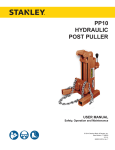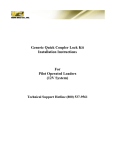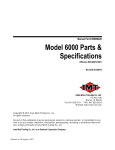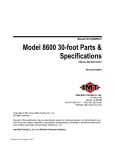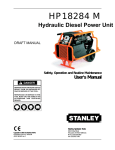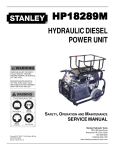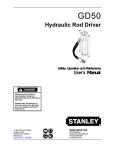Download HYDRAULIC POST PULLER Safety and Operation User's Manual
Transcript
PP10 HYDRAULIC POST PULLER Safety and Operation User’s Manual SERIOUS INJURY OR DEATH COULD RESULT FROM THE IMPROPER REPAIR OR SERVICE OF THIS TOOL. © 2006, THE STANLEY WORKS, ALL RIGHTS RESERVED OPS USA 59020 - 5/2006 Ver 3 REPAIRS AND / OR SERVICE TO THIS TOOL MUST ONLY BE DONE BY AN AUTHORIZED AND CERTIFIED DEALER. INDEX Accessories ..........................................................................................................................15 Index (this page) ....................................................................................................................1 Hydraulic Hose Requirements ..........................................................................................6 - 7 Hydraulic Requirements .........................................................................................................8 Operation ...............................................................................................................................9 Parts Drawing....................................................................................................................... 11 Parts List ..............................................................................................................................12 Safety Precautions ............................................................................................................2 - 3 Specifications .......................................................................................................................13 Tool Stickers and Tags ......................................................................................................4 - 5 Troubleshooting ...................................................................................................................10 Warranty ...............................................................................................................................14 SERVICING THE PP10 POST PULLER: This manual contains safety, operation, service and routine maintenance instructions. Stanley Hydraulic Tools recommends that servicing of hydraulic tools, other than routine maintenance, must be performed by an authorized and certified dealer. Please read the following warning. SERIOUS INJURY OR DEATH COULD RESULT FROM THE IMPROPER REPAIR OR SERVICE OF THIS TOOL. REPAIRS AND / OR SERVICE TO THIS TOOL MUST ONLY BE DONE BY AN AUTHORIZED AND CERTIFIED DEALER. 1 SAFETY PRECAUTIONS Tool operators and maintenance personnel must always comply with the safety precautions given in this manual and on the stickers and tags attached to the tool and hose. These safety precautions are given for your safety. Review them carefully before operating the tool and before performing general maintenance or repairs. Supervising personnel should develop additional precautions relating to the specific work area and local safety regulations. If so, place the added precautions in the space provided on page 3. GENERAL SAFETY PRECAUTIONS The models PP10 Hydraulic Post Puller will provide safe and dependable service if operated in accordance with the instructions given in this manual. Read and understand this manual and any stickers and tags attached to the PP10 before operation. Failure to do so could result in personal injury or equipment damage. • Operator must start in a work area without bystanders. The operator must be familiar with all prohibited work areas such as excessive slopes and dangerous terrain conditions. • Establish a training program for all operators to ensure safe operation. • Do not operate the tool unless thoroughly trained or under the supervision of an instructor. • Always wear safety equipment such as goggles, ear and head protection, and safety shoes at all times when operating the tool. • Do not inspect or clean the tool while the hydraulic power source is connected. Accidental engagement of the tool can cause serious injury. • Always connect hoses to the tool hose couplers before energizing the hydraulic power source. Be sure all hose connections are tight. • Do not operate the tool at oil temperatures above 140°F/60°C. Operation at higher temperatures can cause higher than normal temperatures at the tool which can result in operator discomfort. • Do not operate a damaged, improperly adjusted, or incompletely assembled tool. • Stay clear of all moving parts. • Never wear loose clothing that can get entangled in the working parts of the tool. • To avoid personal injury or equipment damage, all tool repair, maintenance and service must only be performed by authorized and properly trained personnel. • System pressure hose must always be connected to the tool “IN” or “P” port and system return hose must be connected to the tool “OUT” or “T” port. Reversing connections or reversing flow to the tool can result in severe personal injury. • Never use tools near energized transmission lines. Know the location of buried or covered services before starting your work. 2 SAFETY SYMBOLS Safety symbols and signal words, as shown below, are used to emphasize all operator, maintenance and repair actions which, if not strictly followed, could result in a life-threatening situation, bodily injury or damage to equipment. This is the safety alert symbol. It is used to alert you to potential personal injury hazards. Obey all safety messages that follow this symbol to avoid possible injury or death. This safety alert and signal word indicate an imminently hazardous situation which, if not avoided, will result in death or serious injury. This safety alert and signal word indicate a potentially hazardous situation which, if not avoided, could result in death or serious injury. This safety alert and signal word indicate a potentially hazardous situation which, if not avoided, may result in minor or moderate injury. This signal word indicates a potentially hazardous situation which, if not avoided, may result in property damage. This signal word indicates a situation which, if not avoided, will result in damage to the equipment. IMPORTANT This signal word indicates a situation which, if not avoided, may result in damage to the equipment. Always observe safety symbols. They are included for your safety and for the protection of the tool. 3 LOCAL SAFETY REGULATIONS Enter any local safety regulations here. Keep these instructions in an area accessible to the operator and maintenance personnel. TOOL STICKERS & TAGS The safety related stickers and tags attached to the tool prior to shipment from the factory are shown below and on the next page. The pressure and flow rates specified must never be exceeded. All stickers and tags must be read and understood prior to operating the tool. The information listed on these stickers and tags must be legible at all times. Always replace those that have become worn or damaged. Replacements are available from your Stanley distributor. PINCH POINT STAY CLEAR OF ALL MOVING PARTS PINCH POINT WARNING STICKER p/n 17572 WARNING STICKER p/n 35210 NAME TAG PP10 p/n 17573 STANLEY STICKER p/n 05152 4 TOOL STICKERS & TAGS Continued. . . GPM/PRESSURE STICKER p/n 16599 WARNING STICKER p/n 35210 STANLEY STICKER p/n 05152 STANLEY STICKER p/n 05152 PINCH POINT WARNING STICKER p/n 17572 PINCH POINT WARNING STICKER p/n 17572 NAME TAG PP10 p/n 17573 GPM/PRESSURE STICKER p/n 16599 1. FAILURE TO USE HYDRAULIC HOSE LABELED AND CERTIFIED AS NON-CONDUCTIVE WHEN USING HYDRAULIC TOOLS ON OR NEAR ELECTRICAL LINES MAY RESULT IN DEATH OR SERIOUS INJURY. BEFORE USING HOSE LABELED AND CERTIFIED AS NONCONDUCTIVE ON OR NEAR ELECTRIC LINES BE SURE THE HOSE IS MAINTAINED AS NON-CONDUCTIVE. THE HOSE SHOULD BE REGULARLY TESTED FOR ELECTRIC CURRENT LEAKAGE IN ACCORDANCE WITH YOUR SAFETY DEPARTMENT INSTRUCTIONS. 2. A HYDRAULIC LEAK OR BURST MAY CAUSE OIL INJECTION INTO THE BODY OR CAUSE OTHER SEVERE PERSONAL INJURY. The safety tag (p/n 15875) at right is attached to the tool when shipped from the factory. Read and understand the safety instructions listed on this tag before removal. We suggest you retain this tag and attach it to the tool when not in use. A DO NOT EXCEED SPECIFIED FLOW AND PRESSURE FOR THIS TOOL. EXCESS FLOW OR PRESSURE MAY CAUSE A LEAK OR BURST. B DO NOT EXCEED RATED WORKING PRESSURE OF HYDRAU LIC HOSE USED WITH THIS TOOL. EXCESS PRESSURE MAY CAUSE A LEAK OR BURST. C CHECK TOOL HOSE COUPLERS AND CONNECTORS DAILY FOR LEAKS. DO NOT FEEL FOR LEAKS WITH YOUR HANDS. CONTACT WITH A LEAK MAY D DO NOT LIFT OR CARRY TOOL BY THE HOSES. DO NOT ABUSE HOSE. DO NOT USE KINKED, TORN OR DAMAGED HOSE. 3. MAKE SURE HYDRAULIC HOSES ARE PROPERLY CONNECTED TO THE TOOL BEFORE PRESSURING SYSTEM. SYSTEM PRESSURE HOSE MUST ALWAYS BE CONNECTED TO TOOL “IN” PORT. SYSTEM RETURN HOSE MUST ALWAYS BE CONNECTED TO TOOL “OUT” PORT. REVERSING CONNECTIONS MAY CAUSE REVERSE TOOL OPERATION WHICH CAN RESULT IN SEVERE PERSONAL INJURY. 4. DO NOT CONNECT OPEN-CENTER TOOLS TO CLOSED-CENTER HYDRAULIC SYSTEMS. THIS MAY RESULT IN LOSS OF OTHER HYDRAULIC FUNCTIONS POWERED BY THE SAME SYSTEM AND/OR SEVERE PERSONAL INJURY. 5. BYSTANDERS MAY BE INJURED IN YOUR WORK AREA. KEEP BYSTANDERS CLEAR OF YOUR WORK AREA. 6. WEAR HEARING, EYE, FOOT, HAND AND HEAD PROTECTION. 7. TO AVOID PERSONAL INJURY OR EQUIPMENT DAMAGE, ALL TOOL REPAIR MAINTENANCE AND SERVICE MUST ONLY BE PERFORMED BY AUTHORIZED AND PROPERLY TRAINED PERSONNEL. IMPORTANT IMPORTANT READ OPERATION MANUAL AND SAFETY INSTRUCTIONS FOR THIS TOOL BEFORE USING IT. READ OPERATION MANUAL AND SAFETY INSTRUCTIONS FOR THIS TOOL BEFORE USING IT. USE ONLY PARTS AND REPAIR PROCEDURES APPROVED BY STANLEY AND DESCRIBED IN THE OPERATION MANUAL. USE ONLY PARTS AND REPAIR PROCEDURES APPROVED BY STANLEY AND DESCRIBED IN THE OPERATION MANUAL. TAG TO BE REMOVED ONLY BY TOOL OPERATOR. TAG TO BE REMOVED ONLY BY TOOL OPERATOR. SEE OTHER SIDE SEE OTHER SIDE SAFETY TAG P/N 15875 (shown smaller than actual size) 5 TOOL HOSE INFORMATION HOSE TYPES The rated working pressure of the hydraulic hose must be equal to or higher than the relief valve setting on the hydraulic system.There are three types of hydraulic hose that meet this requirement and are authorized for use with Stanley Hydraulic Tools. They are: Certified non-conductive - constructed of thermoplastic or synthetic rubber inner tube, synthetic fiber braid reinforcement, and weather resistant thermoplastic or synthetic rubber cover. Hose labeled certified nonconductive is the only hose authorized for use near electrical conductors. Wire-braided (conductive) - constructed of synthetic rubber inner tube, single or double wire braid reinforcement, and weather resistant synthetic rubber cover. This hose is conductive and must never be used near electrical conductors. Fabric-braided (not certified or labeled non-conductive) - constucted of thermoplastic or synthetic rubber inner tube, synthetic fiber braid reinforcement, and weather resistant thermoplastic or synthetic rubber cover. This hose is not certified non-conductive and must never be used near electrical conductors. hOSE SAFETY TAGS To help ensure your safety, the following DANGER tags are attached to all hose purchased from Stanley Hydraulic Tools. DO NOT REMOVE THESE TAGS. If the information on a tag is illegible because of wear or damage, replace the tag immediately. A new tag may be obtained from your Stanley Distributor. D A N G E R D A N G E R 1 FAILURE TO USE HYDRAULIC HOSE LABELED AND CERTIFIED AS NON-CONDUCTIVE WHEN USING HYDRAULIC TOOLS ON OR NEAR ELECTRIC LINES MAYRESULT IN DEATH OR SERIOUS INJURY. FOR PROPER AND SAFE OPERATION MAKE SURE THAT YOU HAVE BEEN PROPERLY TRAINED IN CORRECT PROCEDURES REQUIRED FOR WORK ON OR AROUND ELECTRIC LINES. 2. BEFORE USING HYDRAULIC HOSE LABELED AND CERTIFIED AS NON-CONDUCTIVE ON OR NEAR ELECTRIC LINES. WIPE THE ENTIRE LENGTH OF THE HOSE AND FITTING WITH A CLEAN DRY ABSORBENT CLOTH TO REMOVE DIRT AND MOSISTURE AND TEST HOSE FOR MAXIMUM ALLOWABLE CURRENT LEAKAGE IN ACCORDANCE WITH SAFETY DEPARTMENT INSTRUCTIONS. 3. DO NOT EXCEED HOSE WORKING PRESSURE OR ABUSE HOSE. IMPROPER USE OR HANDLING OF HOSE COULD RESULT IN BURST OR OTHER HOSE FAILURE. KEEP HOSE AS FAR AWAY AS POSSIBLE FROM BODY AND DO NOT PERMIT DIRECT CONTACT DURING USE. CONTACT AT THE BURST CAN CAUSE BODILY INJECTION AND SEVERE PERSONAL INJURY. 4. HANDLE AND ROUTE HOSE CAREFULLY TO AVOID KINKING, ABRASION, CUTTING, OR CONTACT WITH HIGH TEMPERATURE SURFACES. DO NOT USE IF KINKED. DO NOT USE HOSE TO PULL OR LIFT TOOLS, POWER UNITS, ETC. 5. CHECK ENTIRE HOSE FOR CUTS CRACKS LEAKS ABRASIONS, BULGES, OR DAMAGE TO COUPLINGS IF ANY OF THESE CONDITIONS EXIST, REPLACE THE HOSE IMMEDIATELY. NEVER USE TAPE OR ANY DEVICE TO ATTEMPT TO MEND THE HOSE. 6. AFTER EACH USE STORE IN A CLEAN DRY AREA. SIDE 1 3 DO NOT REMOVE THIS TAG DO NOT REMOVE THIS TAG THE TAG SHOWN BELOW IS ATTACHED TO “CERTIFIED NON-CONDUCTIVE” HOSE SIDE 2 (shown smaller than actual size) D A N G E R D A N G E R 1 DO NOT USE THIS HYDRAULIC HOSE ON OR NEAR ELECTRIC LINES. THIS HOSE IS NOT LABELED OR CERTIFIED AS NON-CONDUCTIVE. USING THIS HOSE ON OR NEAR ELECTRICAL LINES MAY RESULT IN DEATH OR SERIOUS INJURY. 2. FOR PROPER AND SAFE OPERATION MAKE SURE THAT YOU HAVE BEEN PROPERLY TRAINED IN CORRECT PROCEDURES REQUIRED FOR WORK ON OR AROUND ELECTRIC LINES. 5. CHECK ENTIRE HOSE FOR CUTS CRACKS LEAKS ABRASIONS, BULGES, OR DAMAGE TO COUPLINGS IF ANY OF THESE CONDITIONS EXIST, REPLACE THE HOSE IMMEDIATELY. NEVER USE TAPE OR ANY DEVICE TO ATTEMPT TO MEND THE HOSE. 6. AFTER EACH USE STORE IN A CLEAN DRY AREA. 3. DO NOT EXCEED HOSE WORKING PRESSURE OR ABUSE HOSE. IMPROPER USE OR HANDLING OF HOSE COULD RESULT IN BURST OR OTHER HOSE FAILURE. KEEP HOSE AS FAR AWAY AS POSSIBLE FROM BODY AND DO NOT PERMIT DIRECT CONTACT DURING USE. CONTACT AT THE BURST CAN CAUSE BODILY INJECTION AND SEVERE PERSONAL INJURY. 4. HANDLE AND ROUTE HOSE CAREFULLY TO AVOID KINKING, CUTTING, OR CONTACT WITH HIGH TEMPERATURE SURFACES. DO NOT USE IF KINKED. DO NOT USE HOSE TO PULL OR LIFT TOOLS, POWER UNITS, ETC. DO NOT REMOVE THIS TAG DO NOT REMOVE THIS TAG The tag shown below is attached to “conductive” hose. SEE OTHER SIDE SIDE 1 SIDE 2 (shown smaller than actual size) 6 7 51-100 100-300 up to 50 51-100 100-200 up to 25 26-100 19-30 19-30 34-45 34-45 34-45 49-60 49-60 5-8 5-8 9-12 9-12 9-12 13-16 13-16 8-30 up to 8 30-60 15-30 up to 15 30-90 15-30 up to 15 METERS 25.4 19 1 19 3/4 16 5/8 3/4 25.4 19 3/4 1 19 16 5/8 3/4 16 5/8 19 16 5/8 3/4 16 13 MM 5/8 1/2 INCH Inside Diameter SAE 100R1-16 SAE 100R17-12 SAE 100R1-12 SAE 100R2-10 SAE 100R1-16 SAE 100R17-12 SAE 100R1-16 SAE 100R2-10 SAE 100R17-10 SAE 100R1-12 SAE 100R2-10 SAE 100R17-10 SAE 100R17-8 Wire Braid Hose Spec PRESSURE TOOL RETURN 1000 3000 1250 2750 1000 3000 1000 2750 3000 1250 2750 3000 3000 PSI 69 230 86 190 69 230 69 190 230 86 190 230 230 BAR Working Pressure Typical Hose Connections FLOW>>> RETURN MALE PIPE HOSE END <<<FLOW PRESSURE Return Pressure Return Pressure Return Pressure Return Pressure Both Return Pressure Both Both USE MALE PIPE HOSE END NA NA SAE 100R7-12 SAE 100R8-10 NA NA SAE 100R7-12 SAE 100R8-10 SAE 100R8-10 SAE 100R7-12 SAE 100R8-10 SAE 100R8-10 SAE 100R7-8 Fiber Braid Hose Spec NA NA 1250 2750 NA NA 1250 2750 2750 1250 2750 2750 2000 PSI NA NA 86 190 NA NA 86 190 190 86 190 190 140 BAR Operating Pressure PRESSURE H.T.M.A. MALE QUICK DISCONNECT COUPLER ADAPTER OR HOSE WHIPS, 3/8 INCH MALE PIPE x -8 SAE O-RING H.T.M.A. FEMALE QUICK DISCONNECT COUPLER NOTE: SAE 100R16 may be used in place of SAE100R2 FEET up to 50 LPM 19-30 5-8 Each Hose Length GPM Oil Flow Tool To Circuit Hose Recommendations HYDRAULIC CIRCUIT CONTROL PANEL RETURN HYDRAULIC REQUIREMENTS ambient temperature. IMPORTANT In addition to the Safety Precautions on pages 2 thru 5 of this manual, observe the following for equipment protection and care. • Do not exceed the rated limits or use the tool for applications beyond its design capacity. • Always keep critical tool markings, such as labels and warning stickers legible. • Always replace hoses, couplings and other parts with replacement parts recommended by Stanley Hydraulic Tools. Supply hoses must have a minimum working pressure rating of 2500 psi/175 bar. • The hydraulic system should have a minimum of 25 micron filtration. Recommend using filter elements sized for a flow of at least 30 gpm/114 lpm for cold temperature startup and maximum dirt holding capacity. • The hydraulic fluid used should have a viscosity between 100 and 400 ssu/20 and 82 centistokes at the maximum and minimum expected operating temperatures. Petroleum base hydraulic fluids with antiwear properties and a viscosity index over 140 ssu/28 centistokes will meet the recommended requirements over a wide range of operating temperatures. • The recommended hose size is .500 inch/12 mm I.D. up to 50 ft/15 m long and .625 inch/16 mm I.D. minimum up to 100 ft/30 m long. • Permit only experienced personnel to perform tool repair. • Be sure to wipe all couplers clean before connecting. Use only lint-free cloths. • The hydraulic circuit control valve must be in the “OFF” position when coupling or uncoupling the tool. Failure to do so may result in damage to the quick couplers and cause overheating of the hydraulic system. • Check fastener tightness often and before each use daily. Failure to use hydraulic hose labeled and certified as non-conductive when using hydraulic tools on or near electric lines may result in death or serious injury. Make sure that you have been properly trained in correct procedures required for work on or around electric lines. • Quick disconnect couplings must conform to NFPA T3.20,15/HTMA specifications. HYDRAULIC SYSTEM REQUIREMENTS • The hydraulic system should provide a flow of 3-9 gpm/11-34 lpm at an operating pressure of 1000-2000 psi/70-140 bar. Recommended relief valve setting is 2100-2250 psi/145-155 bar. • The system should have no more than 250 psi/17 bar backpressure measured at the tool end of the operating hoses. • The hydraulic system should have enough heat rejection capacity to limit the maximum oil temperature to 140°F/60°C at the maximum expected 8 OPERATION PREOPERATION PROCEDURES difficult to connect. When possible, connect the free ends of operating hoses together. 4. Observe all safety precautions. PREPARATION FOR INITIAL USE Each unit as shipped has no special unpacking or assembly requirements prior to usage. Inspection to assure the unit was not damaged in shipping and does not contain packing debris is all that is required. CHECK HYDRAULIC POWER SOURCE 1. Using a calibrated flowmeter and pressure gauge, check that the hydraulic power source develops a flow of 3-9 gpm/11-34 lpm at 2000 psi/140 bar. 2. Make certain the hydraulic power source is equipped with a relief valve set to open at 21002250 psi/145-155 bar minimum. 5. Move the hydraulic circuit control valve to the “ON” position to operate the tool. TOOL OPERATION 1. Observe all safety precautions. 2. For flanged posts, position the base weldment on a flat surface with the post engaged in the jaws of the tool. 3. For solid or square posts, position the base weldment on a flat surface and wrap a chain around the post. Place the chain in the slots on the post puller frame. 4. Actuate the control lever from the “NEUTRAL” position to the “UP” position until the post raises approximately eight inches. 1. There should be no signs of leaks. 5. Move the control lever from the “UP” position past the “NEUTRAL” position to the “DOWN” position. This releases the jaws (or chain) from the post and lowers the lift frame weldment down to the base weldment (bottom of post). 2. The tool should be clean, with all fittings and fasteners tight. 6. Repeat steps one through five until the post is fully removed. CHECK TOOL CONNECT HOSES 1. Wipe all hose couplers with a clean lint-free cloth before making connections. 2. Connect the hoses from the hydraulic power source to the tool fittings or quick disconnects. It is a good practice to connect the return hose first and disconnect it last to minimize or avoid trapped pressure within the tool. If the post puller is to be used during cold weather, preheat the hydraulic fluid at low engine speed. When using the normally recommended fluids, fluid temperature should be at or above 50 °F/10°C (400 ssu/82 centistokes) before use. 3. Observe flow indicators stamped on hose couplers to be sure that oil will flow in the proper direction. The female coupler is the inlet coupler. Damage to the hydraulic system or post puller can result from use with fluid that is too viscous or thick. NOTE: The pressure increase in uncoupled hoses left in the sun may result in making them 9 COLD WEATHER OPERATION TROUBLESHOOTING If symptoms of poor performance develop, the following chart can be used as a guide to correct the problem. When diagnosing faults in operation of the Post Puller, always check that the hydraulic power PROBLEM Post Puller does not run. Post Puller does not pull. effectively. Post Puller operates slow. Post Puller gets hot. source is supplying the correct hydraulic flow and pressure to the post puller as listed in the table. Use a flowmeter known to be accurate. Check the flow with the hydraulic oil temperature at least 80°F/27°C. POSSIBLE CAUSE SOLUTION Power unit not functioning. Check power unit for proper flow and pressure (3-9 gpm/11-34 lpm, 2000 psi/140 bar). Coupler or hoses blocked. Remove restriction. Mechanical failure of lift cylinder assembly. Disassemble post puller and inspect for damaged parts. Power unit not functioning. Check power unit for proper pressure (2000 psi/140 bar). Couplers or hoses blocked. Remove restriction. Low gpm supply from power unit Check power source for proper flow (3-9 gpm/11-34 lpm). Couplers or hoses blocked. Remove restriction. Relief valve set too low. Adjust relief valve to 2100-2250 psi /145-155 bar. Hot fluid going through tool. Check power unit. Make sure the flow rate is not too high causing part of the fluid to go through the relief valve. Provide cooler to maintain proper fluid temperature (140°F/60°C max). Check relief valve setting. Eliminate flow control devices. 10 11 PR41 PARTS LIST Item No Part No Qty 1 2 3 17533 04985 17553 1 2 2 4 00166 1 5 6 7 8 9 10 11 12 13 14 15 16 17 18 17526 03127 09642 09647 09790 17546 17536 17552 17554 04984 17550 371500 01751 06736 1 1 1 1 2 1 1 1 2 1 1 8 2 4 19 20 21 22 23 24 25 26 27 28 29 30 31 32 33 34 35 01752 35518 18514 17556 17557 17558 17537 17538 01532 17545 17549 17544 17529 17559 17534 17540 17543 33452 17542 33453 17541 00569 03031 16599 05152 17572 17573 19220 19221 1 1 1 2 1 1 4 1 1 1 1 1 1 2 2 2 1 1 1 1 1 2 2 1 2 2 1 1 1 36 37 38 39 40 41 42 43 44 45 Description T-bar Spring Washer Shoulder Screw, 3/4 x 3/4 Hex Socket Head Retaining Ring, 1.850 Heavy Duty (Internal) Seal Retainer Rod Wiper Washer Rod Seal O-ring, 2-1/4 x 2-1/2 x 1/8 Piston Rod Cylinder Piston Wear Ring Elastic Stop Nut, 3/4-16 Hex Lift Frame Weldment Elastic Stop Nut, 1/2-13 Hex O-ring 3/8 x 9/16 x 3/32 Capscrew, 5/16-18 x 2-1/4 Hex Head Adapter Fitting Valve Assembly Guard Weldment Elbow Elbow, 45°-3/8 NPT M-6 Tube Hose Assembly Tie Rod Base Weldment Elbow, 90°-6 SAE/-6 Tube Cylinder Base Cylinder Bearing Adapter Block Chain Assy (Accessory Item) Washer, 7/8 Narrow Type B Modified Capscrew Shoulder Screw Jaw, R.H. (Model PP10100) Jaw, R.H. (Model PP10100A) Jaw, L.H. (Model PP10100) Jaw, L.H. (Model PP10100A) Pivot Block Capscrew, 5/16-18 x 1 Hex Hd Lockwasher, 5/16 GPM Sticker Stanley Sticker Pinch Point Warning Sticker Name Tag TFE Ring O-ring SEAL KIT 19219 Denotes part in seal kit NOTE: Use Part Number and Part Name when ordering. The Following Items Are Not Pictured 35213 2 35149 35212 1 1 24069 1 35210 1 Swivel, Hydraulic Inc.#956P6-P6 (Used on Model PP10100A only) Post (Model PP10100A only) Hitch Pin Assy (Model PP10100A only) Coupler set (Model PP10100A only) Warning Decal (Both Models) 12 SPECIFICATIONS Capacity (Lift per Stroke)...............................................................................................................8 in./20 cm Pulling Force........................................................................................................................9800 lbs/4450 kg Weight..........................................................................................................................................62 lbs/28 kg Flow Range ....................................................................................................................3-9 gpm/ 11-34 lpm Pressure Range...................................................................................................................2000 psi/140 bar Porting..............................................................................................................3/8 NPT Female Pipe Thread Connect Size ................................................................................................................90° Elbow 3/8 Note Weights, dimensions, and operating specifications listed are subject to change without notice. Where specifications are critical to your application, please consult the factory. ACCESSORIES 17529 13 Chain Assy WARRANTY Stanley Hydraulic Tools (hereinafter called “Stanley”), subject to the exceptions contained below, warrants new hydraulic tools for a period of one year from the date of sale to the first retail purchaser, or for a period of 2 years from the shipping date from Stanley, whichever period expires first, to be free of defects in material and/or workmanship at the time of delivery, and will, at its option, repair or replace any tool or part of a tool, or new part, which is found upon examination by a Stanley authorized service outlet or by Stanley’s factory in Milwaukie, Oregon to be DEFECTIVE IN MATERIAL AND/OR WORKMANSHIP. EXCEPTIONS FROM WARRANTY NEW PARTS: New parts which are obtained individually are warranted, subject to the exceptions herein, to be free of defects in material and/or workmanship at the time of delivery and for a period of 6 months after the date of first usage. Seals and diaphragms are warranted to be free of defects in material and/or workmanship at the time of delivery and for a period of 6 months after the date of first usage or 2 years after the date of delivery, whichever period expires first. Warranty for new parts is limited to replacement of defective parts only. Labor is not covered. FREIGHT COSTS: Freight costs to return parts to Stanley, if requested by Stanley for the purpose of evaluating a warranty claim for warranty credit, are covered under this policy if the claimed part or parts are approved for warranty credit. Freight costs for any part or parts which are not approved for warranty credit will be the responsibility of the individual. SEALS & DIAPHRAGMS: Seals and diaphragms installed in new tools are warranted to be free of defects in material and/or workmanship for a period of 6 months after the date of first usage, or for a period of 2 years from the shipping date from Stanley, whichever period expires first. CUTTING ACCESSORIES: Cutting accessories such as breaker tool bits are warranted to be free of defects in material and or workmanship at the time of delivery only. ITEMS PRODUCED BY OTHER MANUFACTURERS: Components which are not manufactured by Stanley and are warranted by their respective manufacturers. a. Costs incurred to remove a Stanley manufactured component in order to service an item manufactured by other manufacturers. ALTERATIONS & MODIFICATIONS: Alterations or modifications to any tool or part. All obligations under this warranty shall be terminated if the new tool or part is altered or modified in any way. NORMAL WEAR: any failure or performance deficiency attributable to normal wear and tear such as tool bushings, retaining pins, wear plates, bumpers, retaining rings and plugs, rubber bushings, recoil springs, etc. INCIDENTAL/CONSEQUENTIAL DAMAGES: To the fullest extent permitted by applicable law, in no event will STANLEY be liable for any incidental, consequential or special damages and/or expenses. FREIGHT DAMAGE: Damage caused by improper storage or freight handling. LOSS TIME: Loss of operating time to the user while the tool(s) is out of service. IMPROPER OPERATION: Any failure or performance deficiency attributable to a failure to follow the guidelines and/or procedures as outlined in the tool’s operation and maintenance manual. MAINTENANCE: Any failure or performance deficiency attributable to not maintaining the tool(s) in good operating condition as outlined in the Operation and Maintenance Manual. HYDRAULIC PRESSURE & FLOW, HEAT, TYPE OF FLUID: Any failure or performance deficiency attributable to excess hydraulic pressure, excess hydraulic back-pressure, excess hydraulic flow, excessive heat, or incorrect hydraulic fluid. REPAIRS OR ALTERATIONS: Any failure or performance deficiency attributable to repairs by anyone which in Stanley’s sole judgement caused or contributed to the failure or deficiency. MIS-APPLICATION: Any failure or performance deficiency attributable to mis-application. “Mis-application” is defined as usage of products for which they were not originally intended or usage of products in such a matter which exposes them to abuse or accident, without first obtaining the written consent of Stanley. PERMISSION TO APPLY ANY PRODUCT FOR WHICH IT WAS NOT ORIGINALLY INTENDED CAN ONLY BE OBTAINED FROM STANLEY ENGINEERING. WARRANTY REGISTRATION: STANLEY ASSUMES NO LIABILITY FOR WARRANTY CLAIMS SUBMITTED FOR WHICH NO TOOL REGISTRATION IS ON RECORD. In the event a warranty claim is submitted and no tool registration is on record, no warranty credit will be issued without first receiving documentation which proves the sale of the tool or the tools’ first date of usage. The term “DOCUMENTATION” as used in this paragraph is defined as a bill of sale, or letter of intent from the first retail customer. A WARRANTY REGISTRATION FORM THAT IS NOT ALSO ON RECORD WITH STANLEY WILL NOT BE ACCEPTED AS “DOCUMENTATION”. NO ADDITIONAL WARRANTIES OR REPRESENTATIONS This limited warranty and the obligation of Stanley thereunder is in lieu of all other warranties, expressed or implied including merchantability or fitness for a particular purpose except for that provided herein. There is no other warranty. This warranty gives the purchaser specific legal rights and other rights may be available which might vary depending upon applicable law. 14 Hydraulic Tools 3810 S.E. Naef Road Milwaukie, Oregon 97267-5698 Phone: 503/659-5660 Fax: 503/652-1780
















